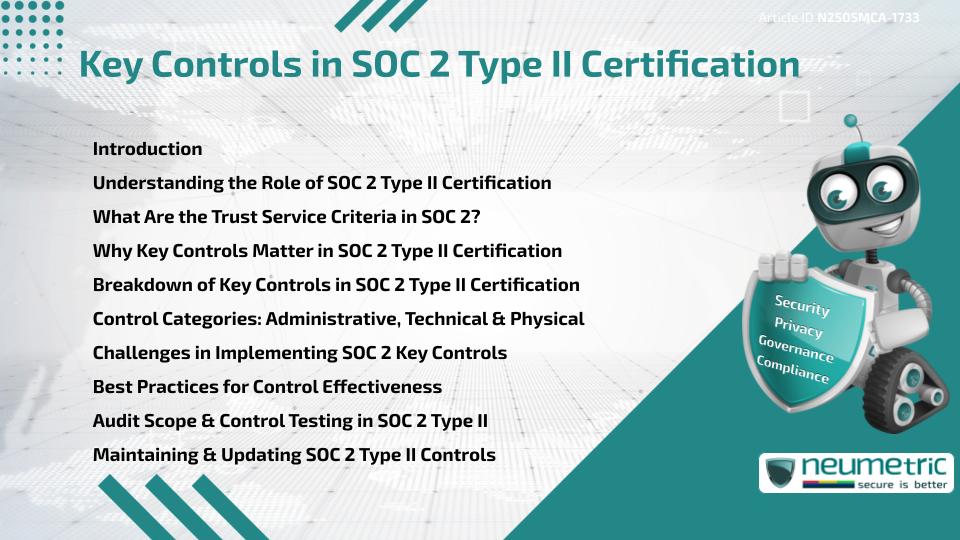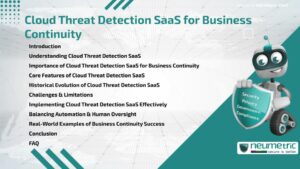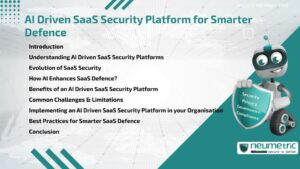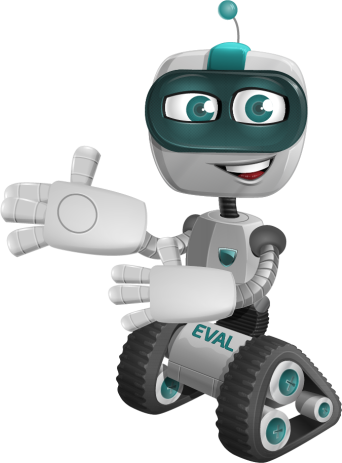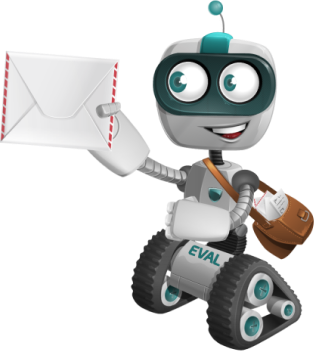Table of Contents
ToggleIIntroduction
SOC 2 Type II Certification has become a Standard benchmark for Data Security & operational maturity in Service-based Companies. Whether you are a Software as a Service [SaaS] Provider or a Cloud Service Company, the Certification ensures you meet Customer & regulatory expectations around data handling & Privacy. A central part of this Certification lies in the implementation & monitoring of Key Controls.
In this article, we explore the Key Controls in SOC 2 Type II Certification, how they align with the five Trust Service Criteria, the challenges involved & practical Best Practices to maintain effectiveness.
Understanding the Role of SOC 2 Type II Certification
System & Organisation Controls 2 [SOC 2] is a Framework developed by the American Institute of Certified Public Accountants [AICPA]. Type II reports evaluate the operating effectiveness of Controls over a monitoring period—usually twelve (12) months. Unlike Type I, which checks control design at a single point in time, Type II assesses how well those Controls actually perform.
SOC 2 Type II Certification is especially crucial for technology-driven businesses that handle sensitive Customer Data. It offers assurance to clients, partners & regulators that the Organisation is committed to Information Security.
Learn more from the official AICPA overview of SOC reports.
What Are the Trust Service Criteria in SOC 2?
SOC 2 Type II Controls are based on five Trust Service Criteria:
- Security: Protection of system resources against unauthorized access.
- Availability: Making sure Systems & Products are operational.
- Processing Integrity: Making sure System processing is complete, correct & appropriate.
- Confidentiality: Restricting access & disclosure of sensitive information.
- Privacy: Managing Personal Data in accordance with applicable laws.
These criteria guide the selection & design of Key Controls in SOC 2 Type II Certification. Each Organisation chooses which criteria are in scope based on their service offerings.
Why Key Controls Matter in SOC 2 Type II Certification
Key Controls are safeguards that ensure your Systems & Data are secure, available & properly managed. They demonstrate that your Organisation consistently meets the selected Trust Service Criteria over time.
In SOC 2 Type II, Key Controls are not only documented but also tested for operational effectiveness. This testing is conducted by independent auditors, which gives the Certification its credibility.
Failing to design effective Key Controls can result in Audit exceptions, report qualifications or Certification failure.
Breakdown of Key Controls in SOC 2 Type II Certification
The Key Controls in SOC 2 Type II Certification usually fall under the following areas:
Access Controls
- Role-based Access Restrictions
- User provisioning & de-provisioning
- Multi-factor authentication [MFA]
Change Management
- Change request documentation
- Approval workflows
- Rollback Procedures
Incident Response
- Detection of Security Events
- Defined escalation paths
- Post-incident analysis
Data Backup & Recovery
- Scheduled Data Backups
- Testing of Disaster Recovery Plans
- Offsite storage & redundancy
System Monitoring
- Real-time log analysis
- Alerting mechanisms
- Periodic Vulnerability Scans
For a deeper dive into these categories, the Cloud Security Alliance’s Control Matrix provides a useful reference.
Control Categories: Administrative, Technical & Physical
SOC 2 Controls are often divided into three broad categories:
- Administrative Controls: Policies, training & Governance frameworks
- Technical Controls: Firewalls, encryption, access logs & automation tools
- Physical Controls: Data center access restrictions, surveillance systems & visitor logs
This classification helps Organisations map their Controls more systematically & provides clarity for both internal teams & auditors.
Challenges in Implementing SOC 2 Key Controls
Despite the clarity of the Framework, Organisations often face several challenges:
- Limited Resources: Small teams may lack the personnel to monitor all control areas.
- Tool Overload: Too many overlapping tools can complicate monitoring & reporting.
- Documentation Gaps: Incomplete or inconsistent evidence makes audits difficult.
Some of these challenges can be addressed by leveraging purpose-built platforms, but success also depends on process discipline & continuous learning.
The National Cybersecurity Center of Excellence offers frameworks & tools to help address implementation barriers.
Best Practices for Control Effectiveness
Here are some Best Practices to ensure your Controls meet SOC 2 expectations:
- Conduct regular internal control reviews
- Use automation for Evidence Collection
- Maintain version-controlled documentation
- Train Employees on Compliance responsibilities
- Align Controls with business-specific Risks
An excellent open-source resource for aligning Controls is the Center for Internet Security Controls.
Audit Scope & Control Testing in SOC 2 Type II
During a SOC 2 Type II Audit, auditors assess whether the Key Controls operated effectively over the review period. They check for:
- Evidence that Controls were applied consistently
- Records of incidents & how they were managed
- Logs & reports showing Compliance with Policies
Auditors may use sampling methods or test all instances depending on the control type & significance.
Maintaining & Updating SOC 2 Type II Controls
SOC 2 is not a one-time project. Controls must be updated to reflect changes in:
- Organizational structure
- Technology stack
- Regulatory obligations
Failing to evolve your Controls can make your SOC 2 Type II report obsolete or misleading. Establishing a Governance process to review & update Controls quarterly can prevent this Risk.
Takeaways
- SOC 2 Type II Certification requires continuous validation of Controls over time.
- The Key Controls in SOC 2 Type II Certification align with five Trust Service Criteria.
- These Controls are grouped into administrative, technical & physical categories.
- Successful implementation involves automation, clear documentation & staff awareness.
- Regular updates & audits help maintain Certification relevance.
FAQ
What are the Key Controls in SOC 2 Type II Certification?
They include Access Control, Change Management, System Monitoring, Incident Response & Data Backup measures that align with Trust Service Criteria.
How long is the monitoring period for SOC 2 Type II controls?
It is usually over a period of twelve (12) months to demonstrate consistent performance.
Who is responsible for implementing these Key Controls?
Typically, the Compliance team along with IT, Security & Operations teams share responsibility for design & implementation.
Can controls be automated in SOC 2 Type II Certification?
Yes, many controls like logging, alerting & access reviews can be automated for efficiency & consistency.
Are Key Controls the same for every Organisation?
No, they vary based on the chosen Trust Service Criteria & the nature of services offered by the Organisation.
How are SOC 2 Type II Controls tested?
Auditors review supporting evidence such as logs, Policies & system records to confirm control effectiveness.
What happens if a key control fails during the Audit?
A failed control may result in a qualified opinion or remediation request, depending on its impact.
Is SOC 2 Type II Certification mandatory?
It is not legally mandatory but is often required by customers, especially in regulated industries.
References
- AICPA SOC 2 Overview
- Cloud Controls Matrix – Cloud Security Alliance
- National Cybersecurity Center of Excellence (NCCoE)
- Center for Internet Security Controls
Need help?
Neumetric provides organisations the necessary help to achieve their Cybersecurity, Compliance, Governance, Privacy, Certifications & Pentesting goals.
Organisations & Businesses, specifically those which provide SaaS & AI Solutions, usually need a Cybersecurity Partner for meeting & maintaining the ongoing Security & Privacy needs & requirements of their Clients & Customers.
SOC 2, ISO 27001, ISO 42001, NIST, HIPAA, HECVAT, EU GDPR are some of the Frameworks that are served by Fusion – a centralised, automated, AI-enabled SaaS Solution created & managed by Neumetric.
Reach out to us!

